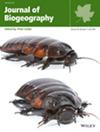Dramatic Increases in Net Diversification Rates and Key Innovations Explain Rich Diversity and High Biomass of Arethuseae (Orchidaceae) in Asian Tropical and Subtropical Mountain Ecosystems
Abstract
Aims
Asian tropical and subtropical mountain systems (ATSME) encompass a diverse group of complex ecosystems ranging from tropical rainforests and subtropical rainforests to alpine grassland. ATSME provide a good chance to explore the mechanisms underlying the pattern of mountain biodiversity patterns, and various hypotheses have been proposed. We aim to characterise diversification in Arethuseae and its driving factors in Asian tropical and subtropical mountain ecosystems and test the hypothesis that specific key innovations had an influence on the diversification rates.
Location
Asian tropical and subtropical mountain ecosystems.
Taxon
Arethuseae (Orchidaceae), a group of 700 species mainly endemic in Asian tropical and subtropical mountain ecosystems.
Methods
The phylogenetic relationships of Arethuseae were reconstructed based on protein-coding genes of plastid genomes of 75 species + nrITS + 8 plastid genes for 191 species of Arethuseae, representing 96% of the genera (except Aglossorrhyncha) and 30% of the species in the Arethuseae. Phylogenetic analyses were conducted using maximum likelihood (ML) and Bayesian inference (BI) methods. Divergence times were analysed using BEAST v1.10.4. Diversification rates were estimated using BAMM v2.5.0. Ancestral areas of Arethuseae were reconstructed using RASP v.4.3. The D statistic was used to test the phylogenetic signal of pseudobulb traits and epiphytic habits during the evolution of the phylogenetic tree of Arethuseae. A maximum entropy algorithm was used to model habitat suitability of Arethuseae.
Results
Arethuseae originated in the Asian tropical and subtropical monsoon areas, with diversification at the Oligocene–Miocene boundary. It was not until the mid-Miocene that Arethuseae began to diversify rapidly. The genera that diverged from the mid-Miocene were all epiphytic and most had pseudobulbs. Dramatic increases in situ diversification rates of Arethuseae began to diversify rapidly from mid-Miocene.
Main Conclusions
Asian tropical and subtropical mountain ecosystems might serve as both cradles and museums for diversification in Arethuseae. The innovation of pseudobulbs and epiphytic habit may have provided evolutionary opportunities for adaptive radiation of Arethuseae. The intensification of the Asian monsoon and expansion of montane rainforests as well as their interactions were crucial for the formation and maintenance of mountain biodiversity in Asia.

 求助内容:
求助内容: 应助结果提醒方式:
应助结果提醒方式:


